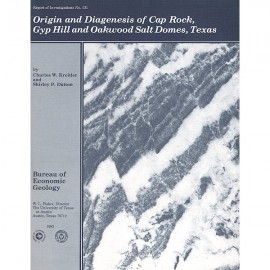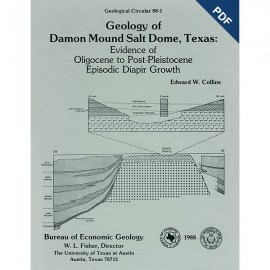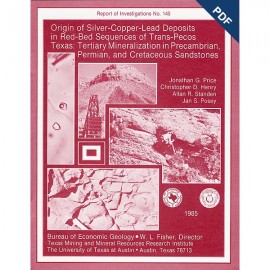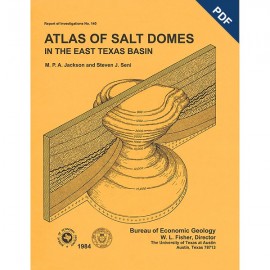Reports of Investigations
-
Books & Reports
- Reports of Investigations
- Guidebooks
- Udden Series
- Geological Circulars
- Down To Earth
- Atlases of Major Oil and Gas Reservoirs
- Texas Memorial Museum Publications
- Environmental Geologic Atlas of the Texas Coastal Zone
- Mineral Resource Circulars
- Other Reports
- Seminars and Workshops
- Handbooks
- Submerged Lands of Texas
- Symposia
- Annual Reports
- Open File Reports
-
Maps & Cross Sections
- Thematic Maps
- Miscellaneous Maps, Charts & Sections
- Geologic Atlas of Texas
- STATEMAP Project Maps
- Geologic Quadrangle Maps
- Cross Sections
- Highway Geology Map
- Energy and Mineral Resource Maps
- Shoreline Change and Other Posters
- Wilcox Group, East Texas, Geological / Hydrological Folios
- Bouguer Gravity Atlas of Texas
- River Basin Regional Studies
- Featured Maps
- Posters
- Teachers & the Public
-
Geological Society Publications
- Gulf Coast Association of Geological Societies
- Alabama Geological Society
- Austin Geological Society
- Corpus Christi Geological Society
- Houston Geological Society
- Lafayette Geological Society
- Mississippi Geological Society
- New Orleans Geological Society
- South Texas Geological Society
- GCS SEPM Publications
- Historic BEG & UT Series
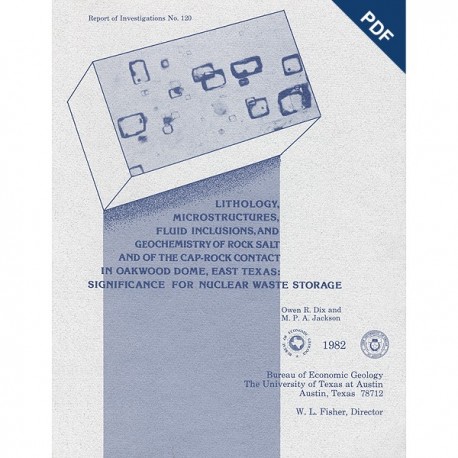
Lithology, Microstructures, ... and Geochemistry of Rock Salt ... in Oakwood Dome. Digital Download
RI0120D
A free, digital version of this publication can be found on: Texas ScholarWorks
To purchase a print version (if available): RI0120
RI0120D. Lithology, Microstructures, Fluid Inclusions, and Geochemistry of Rock Salt and of the Cap-Rock Contact in Oakwood Dome, East Texas: Significance for Nuclear Waste Storage, by O. R. Dix and M. P. A. Jackson. 59 p., 37 figs., 6 tables, 1 appendix, 1982. doi.org/10.23867/RI0120D. Downloadable PDF.
To purchase this publication in book format, please order RI0120.
ABSTRACT
Oakwood salt dome in Leon and Freestone Counties, Texas, has a core composed of a diapiric salt stock at a depth of 355 m. A vertical borehole in the center of the salt stock yielded 57.3 m of continuous rock-salt core overlain by 137 m of anhydrite-calcite cap rock. The lower 55.3 m of rock salt exhibits a strong, penetrative schistosity and parallel cleavage dipping at 30° to 40° and more than 60 variably dipping layers of disseminated anhydrite. Anhydrite constitutes 1.3 ± 0.7 percent of the rock-salt core. The upper 2 m of rock salt is unfoliated, comprising a lower 1.4-m interval of medium-grained granoblastic rock salt and an upper 0.6-m interval of coarse-grained granoblastic rock salt. An abrupt, cavity-free contact separates rock salt from laminated cap rock consisting of granoblastic-polygonal anhydrite virtually devoid of halite or pore space.
Microstructures and concentration gradients of fluid inclusions suggest that the unfoliated rock salt at the crest of the salt stock was once strongly foliated, but that this fabric was destroyed by solid-state recrystallization. Downward movement of brine from the rock-salt - cap-rock contact was apparently accompanied by two recrystallization fronts. Dissolution of halite at the contact released disseminated anhydrite that presumably accumulated as sand on the floor of the dissolution cavity. Renewed rise of the salt stock closed the cavity, and the anhydrite sand was accreted against the base of the cap rock. Much, if not all, of the lamination in the 80 m of anhydrite cap rock may result from cycles of dissolution, recrystallization, and upward movement in the salt stock, followed by accretion of base of the cap rock. These processes, which are strongly influenced by fluids, act both to breach waste repositories and to geologically isolate them. Despite repeated attrition and uplift of the salt stock, the geologic system has the ability to offset, at least partially, these negative processes by self-sealing and recovery.
Keywords: Freestone County, Leon County, Texas, Oakwood Dome, salt domes, cap rock, geochemistry, East Texas Basin, nuclear waste storage
Contents
ABSTRACT
INTRODUCTION
GEOLOGY OF OAKWOOD DOME
LITHOLOGY AND MICROSTRUCTURES
Foliated rock salt (R-1 zone)
Unfoliated rock salt
Medium-grained R-2 zone
Coarse-grained R-3 zone
Contact between rock salt and cap rock
Lamination in the contact zone
FLUID INCLUSIONS
Brine inclusions
Origin of brine inclusions
Compressed-gas inclusions
Pressures and temperatures during halite recrystallization
GEOCHEMISTRY
ORIGIN OF ANHYDRITE CAP ROCK
SUMMARY
SIGNIFICANCE FOR STORAGE OF NUCLEAR WASTES
ACKNOWLEDGMENTS
REFERENCES
APPENDIX: Oakwood Salt-Core Log
Figures
1. Map showing the East Texas Basin and location of Oakwood Dome
2. Northwest-southeast cross section of Oakwood Dome
3. Profile of the TOG-1 rock-salt core showing the three zones
4. Mesoscopic open folding of disseminated-anhydrite layer in foliated rock salt
5. Dismembered and contorted anhydrite-rich layers in pale. medium-grained rock salt
6. Mesoscopic structure in the interval containing anhydrite-rich layers
7. Coarse-to-medium grained rock salt containing dark, medium-grained disseminated-anhydrite layer
8. Halite grain boundaries in the R-1 and R-2 zones
9. Intercrystalline network of liquid along halite grain boundaries in foliated rock salt
10. Anhydrite crystal showing pitted and unpitted areas
11. Irregular network of unpitted areas on an anhydrite crystal
12. Preferred orientation in anhydrite-rich layer on the limb of a microfold
13. Contact between the foliated R-1 zone and the unfoliated R-2 zone
14. Millimeter-scale transposition of a disseminated-anhydrite layer in the medium-grained unfoliated R-2 zone
15. Schematic diagram showing inferred anhydrite and halite microstructure in a disseminated-anhydrite layer during successive stages of transposition
16. Abrupt contact between medium-grained unfoliated rock salt from the R-2 zone and coarse-grained unfoliated rock salt from the R-3 zone
17. Possible evolution of the R-2 and R-3 zones of unfoliated rock salt
18. Abrupt contact between cap rock and rock salt of the R-3 zone
19. Schematic diagram of the rock-salt cap-rock contact zone, showing the transition zones
20. Anhydrite grains surrounded by halite in the transition zones
21. Base of the cap rock consisting of equant anhydrite
22. Percentage of idioblastic anhydrite, mean anhydrite grain size, and anhydrite axial ratios across the rock-salt/cap-rock contact
23. Contact between rock salt and cap rock
24. Explanatory diagram of specimen in figure 23
25. Block diagram of the drip hypothesis, illustrating formation of splash crater and accretion of anhydrite
26. Two different thicknesses of layers at the base of the anhydrite cap
27. Solution cleavage cutting across contorted laminae in the base of the anhydrite cap rock
28. Undulating upper contact of a rock-salt layer enclosed in anhydrite cap rock
29. Brine inclusions within a halite grain of recrystallized R-3 rock salt
30. Irregular brine inclusion in halite grain from the R-3 zone
31. Graph showing the concentration of cuboid brine inclusions in R-3 rock salt .
32. Irregular film of liquid on an anhydrite crystal enclosed in halite
33. Elongated fillet of brine between two anhydrite crystals in halite
34. Anhydrite grain containing a bubble-bearing fluid inclusion
35. Bubbles of decompressed gas released from anhydrite-halite grain boundaries during experimental dissolution of halite in water
36. Compressed-gas inclusions in rock salt isolated within the anhydrite cap rock
37. Laminae in lowermost cap rock from Oakwood and Hockley Domes
Tables
1. Grain-size data for laminae a t the base of the anhydrite cap
2. Fluid-inclusion data and anhydrite percentage for R-3 rock salt
3. Anhydrite contents of rock salt and bromine contents of halite
4. Sequence of events in rock salt and base of cap rock
5. Processes detrimental to nuclear-waste storage
6. Processes favorable for nuclear-waste storage
Citation
Dix, O. R., and Jackson, M.P.A., 1982, Lithology, Microstructures, Fluid Inclusions, and Geochemistry of Rock Salt and of the Cap-Rock Contact in Oakwood Dome, East Texas: Significance for Nuclear Waste Storage: The University of Texas at Austin, Bureau of Economic Geology, Report of Investigations No. 120, 59 p.

